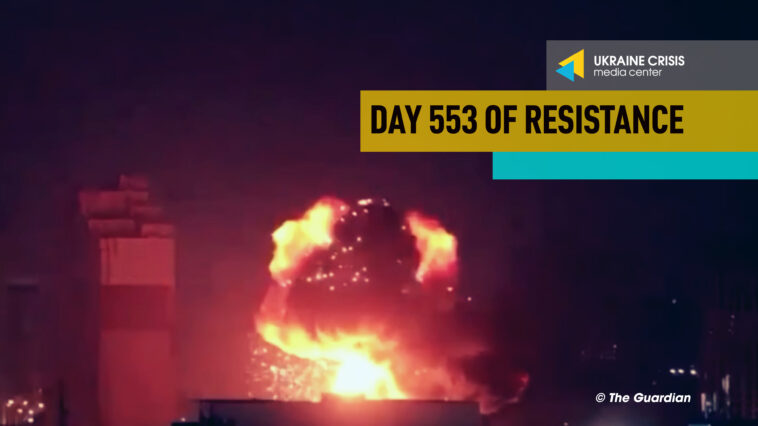Russia launches a major drone and missile attacks, specifically targets Kyiv. Drones destroy four IL-76 military cargo planes in Pskov in the biggest drone attack on Russia. Estonia urges the EU to speed up ammunition deliveries to Ukraine, expand funds under the European Peace Facility.
Russia launches major drone and missile attacks across Ukraine, specifically targets Kyiv
Overnight on August 30, Russia conducted a major attack on Ukraine, launching drones and missiles in several waves. Ukrainian troops shot down 15 of 16 Shahed-136/131 drones and all 28 air-launched Kh-101/Kh-555/Kh-55 missiles that Russia fired from 11 Tu-95MS strategic bombers over the Caspian Sea and from near Engels. Ukraine’s air defenses shot down missiles and drones over Kyiv, Cherkasy, Odesa, and Mykolayiv regions.
According to the head of the Kyiv city military administration, Serhiy Popko, at least 20 air targets were destroyed in the skies over Kyiv. That’s the most powerful attack on Kyiv since spring, he said. Two men were killed by falling debris. These were security guards at an industrial facility ages 26 and 36. Three more people were injured. The wreckage caused destruction and set ablaze non-residential facilities in the Shevchenkivskyi and Darnytskyi districts of the city.
In Kyiv region, missile and drone debris damaged private houses, garages and a cemetery in several towns and villages. Three people were injured. In Zhytomyr region, the attack damaged an infrastructural facility and railway tracks. Later that day, train traffic there was restored. Ukraine’s air defenses destroyed eight missiles over the Black Sea in Odesa region. No missiles hit targets or caused damage there. Another missile was shot down over Cherkasy region.
Drones destroy four IL-76 military cargo planes in Pskov in biggest drone attack on Russia
The Main Intelligence Department of Ukraine’s Defense Ministry confirmed that four Russian IL-76 military cargo planes were destroyed in a drone attack on the Pskov airfield in Russia overnight on Wednesday, August 30.
“Four planes have been destroyed, they cannot be rebuilt. Possibly two more planes were damaged, this is yet to be confirmed,” representative of the Main Intelligence Department of Ukraine’s Defense Ministry Andriy Yusov told Ukrainska Pravda.
The episode is part of what appears to be one of the biggest drone attacks on Russia since it launched a full-scale invasion of Ukraine. At least six regions came under drone attacks overnight on Wednesday, including the Pskov, Bryansk, Oryol, Ryazan, Kaluga, and Moscow regions. According to local social media reports, one of the drones that was shot down over Bryansk, fell on the Kremny EL plant, one of Russia’s largest microelectronics factories. Russian-installed authorities in Crimea said they also thwarted a drone attack from the sea.
Estonia urges EU to speed up ammunition deliveries to Ukraine, expand funds under European Peace Facility
The EU lags behind the pace of delivering ammunition and missiles to Ukraine. It has to use all possibilities to move on its plan to provide one million shells in the next 12 months, Estonia’s Defense Minister Hanno Pevkur told reporters at a meeting of EU defense ministers in Toledo, Spain, on August 29-30.
“We initiated the program of one million rounds for Ukraine, and we have to continue with that. We have not reached the target yet, and we have to do more. We have several options for that. First, we have to dig into our stockpiles. Second, we have to look at whether we could refurbish old rounds. And, third, if that’s not enough, we need to look at an option to buy [ammunition] from third countries,” Pevkur said.
In the past six months, the EU sent 226,000 shells to Ukraine, which makes up one-fourth of the planned total, he added.
Commenting on a potential increase of funds under the European Peace Facility to keep Ukraine’s military stocked for the next four years at a cost of up to EUR 20 billion, Pevkur said Estonia was favorable to the proposal.
“Just imagine, the European Union’s GDP is roughly EUR 16 trillion. We have spent EUR 4.6 billion from the European Peace Facility, which makes up 0.03 per cent of the GDP. This is what we have given to Ukraine. We can obviously do more. This is one of the goals, and this EUR 20 billion will help to achieve that,” he said.




